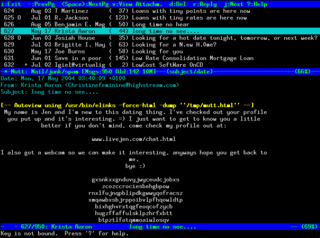
Electronic mail is a method of transmitting and receiving messages using electronic devices. It was conceived in the late–20th century as the digital version of, or counterpart to, mail. Email is a ubiquitous and very widely used communication medium; in current use, an email address is often treated as a basic and necessary part of many processes in business, commerce, government, education, entertainment, and other spheres of daily life in most countries.
In computing, the Internet Message Access Protocol (IMAP) is an Internet standard protocol used by email clients to retrieve email messages from a mail server over a TCP/IP connection. IMAP is defined by RFC 9051.
Within the Internet email system, a message transfer agent (MTA), or mail transfer agent, or mail relay is software that transfers electronic mail messages from one computer to another using the Simple Mail Transfer Protocol. In some contexts the alternative names mail server, mail exchanger, and MX host can be used to describe an MTA.
In computing, the Post Office Protocol (POP) is an application-layer Internet standard protocol used by e-mail clients to retrieve e-mail from a mail server. Today, POP version 3 (POP3) is the most commonly used version. Together with IMAP, it is one of the most common protocols for email retrieval.

An email client, email reader or, more formally, message user agent (MUA) or mail user agent is a computer program used to access and manage a user's email.
A message delivery agent (MDA), or mail delivery agent, is a computer software component that is responsible for the delivery of e-mail messages to a local recipient's mailbox. It is also called a local delivery agent (LDA).

Apple Mail is an email client included by Apple Inc. with its operating systems macOS, iOS, iPadOS and watchOS. Apple Mail grew out of NeXTMail, which was originally developed by NeXT as part of its NeXTSTEP operating system, after Apple's acquisition of NeXT in 1997.

Mutt is a text-based email client for Unix-like systems. It was originally written by Michael Elkins in 1995 and released under the GNU General Public License version 2 or any later version.

Pegasus Mail is a proprietary email client developed by David Harris. It was originally released in 1990 for internal and external mail on NetWare networks with MS-DOS and later Apple Macintosh clients. It was subsequently ported to Microsoft Windows, which is now the only platform actively supported. Previously freeware, Pegasus Mail is now donationware.
Calendaring Extensions to WebDAV, or CalDAV, is an Internet standard allowing a client to access and manage calendar data along with the ability to schedule meetings with users on the same or on remote servers. It lets multiple users in different locations share, search and synchronize calendar data. It extends the WebDAV specification and uses the iCalendar format for the calendar data. The access protocol is defined by RFC 4791. Extensions to CalDAV for scheduling are standardized as RFC 6638. The protocol is used by many important open-source applications.
The following tables compare general and technical features of notable email client programs.

Dovecot is an open-source IMAP and POP3 server for Unix-like operating systems, written primarily with security in mind. Timo Sirainen originated Dovecot and first released it in July 2002. Dovecot developers primarily aim to produce a lightweight, fast and easy-to-set-up open-source email server.
The UW IMAP server was the reference server implementation of the Internet Message Access Protocol. It was developed at the University of Washington by Mark Crispin and others.
Sieve is a programming language that can be used for email filtering. It owes its creation to the CMU Cyrus Project, creators of Cyrus IMAP server.
The comparison of mail servers covers mail transfer agents (MTAs), mail delivery agents, and other computer software that provide e-mail services.
Bynari is a defunct company based in Dallas, developing server and email software, mainly known for its Insight Family, similar to Microsoft Exchange Server with Outlook.
A mailbox is the destination to which electronic mail messages are delivered. It is the equivalent of a letter box in the postal system.

An e-mail agent is a program that is part of the e-mail infrastructure, from composition by sender, to transfer across the network, to viewing by recipient. The best-known are message user agents and message transfer agents, but finer divisions exist.

Mailfence is an encrypted email service that offers OpenPGP based end-to-end encryption and digital signatures. It was launched in November 2013 by ContactOffice Group, which has been operating an online collaboration suite for universities and other organizations since 1999.
The JSON Meta Application Protocol (JMAP) is a set of related open Internet Standard protocols for handling email. JMAP is implemented using JSON APIs over HTTP and has been developed as an alternative to IMAP/SMTP and proprietary email APIs such as Gmail and Outlook. Additional protocols and data models being built on top of the core of JMAP for handling contacts and calendar synchronization are meant to be potential replacements for CardDAV and CalDAV, and other support is currently in the works.







